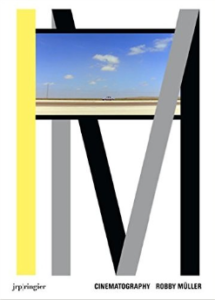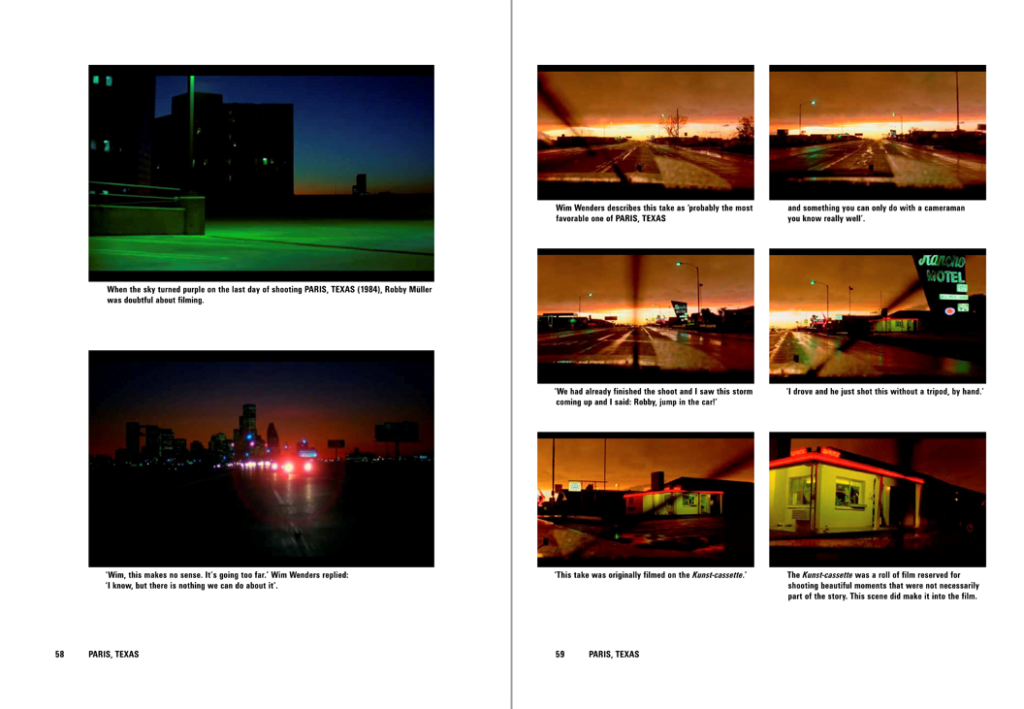
When I visited the EYE Film Institute of the Netherlands in Amsterdam, I bought a book called ‘Cinematography – Robby Muller’ that was compiled by Linda van Deursen and Marietta de Vries. It has turned out to be one of the most inspiring and informative books I have read to date. Rather bizarrely, the book contains very little text and as a consequence obliged me to look more critically and come to my own conclusions.
The book is essentially a series of stills from 14 of the films for which he was Director of Photography. The stills aim to show the viewer Muller’s treatment of light in filming. Each set of stills is accompanied by minimal commentary from either the Director of the film or some of Muller’s assistants and collaborators. I’ve included a snapshot below of one of the pages to provide an idea of the format.

I had seen some of the films covered in the book, but others I was not familiar with and this lack of knowledge allowed me to look at the images without any bias towards what I was seeing. I learnt a number of things from looking at the stills this way:
- In one particular scene in ‘Saint Jack’ two characters are walking together through a park in broad daylight. As their walk progresses gradually they are partially obscured by the shadow from the park trees. Muller does not change the exposure but allows them to remain obscured. One of the characters makes some type of proposal which is unexpected (and presumably problematic) and at this point both characters are completely obscured by shadow and it is only possible to see their outlines. I found this a fascinating and cleanly simple way of using natural lighting/shadow to signify that something is not quite right. The idea of darkness in broad daylight is immensely appealing.
- In ‘Der Amerikanische Freud’, two characters are on the Hamburg U-bahn and having a conversation. The book states that the scene lasts about two minutes. Within that time, the number of light changes is incredible and at the same time feels perfectly natural – artificial light from the train station, shifting light as the train moves, direct sunlight hitting their faces, partial light and dark shadows as they enter a station. What I have wondered about with this sequence is whether Muller took the approach that the light will just happen naturally and he will simply capture it, or did he plan it and make sure it happened the way he planned, i.e. was what appears to be natural light, really artificially set up or not.
- Also in ‘Der Amerikanische Freud’ there are a number of examples of light use that indicates the presence of someone – typically by seeing that a light has been switched on somewhere without seeing who switched it on. Looking at these images, I had the sense of them being a simple lighting equivalent of implied meaning. It also got me thinking about how it is not necessary to be visually obvious – a light being switched on is enough; if the context is correct the viewer is likely to work out who is there, or that could be part of the story (not knowing who is there or assuming it is someone that it is not).
- In ‘Barfly‘, light is used to disturb the atmosphere. The first shot is of a cozy, intimate scene in a bar where all appear at ease with bodies relaxed and comfortable and the light is low. In the following shot, the same scene is lit by harsh daylight. Although the viewer does not see the bar door being opened, it can be assumed that this is the source of the light. The atmosphere changes – it feels exposed, as if shining a light on secrets and the people are less relaxed.
- There is fascinating set of two stills that come from ‘Mystery Train’ that show the different lighting of the same scene at night and then in the early morning. Two characters are lying in a bed together – they are partially lit by an off-screen bedside lamp. The next shot is of the same two characters lying in the same position but the light has subtly changed even though it is still casting very similar shadows to the previous shot. The source of light is now presumably the weak morning sun coming through a window. It’s incredible how such a tiny shift in light can change the perception of what time of day it is.
This is without doubt one of the most fascinating books that I have ‘read’. It has forced me to look, to ask my own questions and draw my own conclusions. It triggered me to search out some the films that were featured but in other instances, I didn’t need to know the context because the learning could take place without the context.
I have covered only five examples of what I have learnt from this book but there are many more and I am sure that in time, when I revisit this book, as I know I will, there will be more to learn. Simply brilliant.
Bibliography:
van Deursen, L and de Vries, M. (2013). Cinematography Robby Muller. Zurich: JRP|Ringier.

Hi Peter. Glad to hear you bought the book. I love Robby’s work so this book was a definite for me. The real bonus though is that it is so visual – it has helped me to think in terms of ‘show me, don’t tell me’. When it comes to the use of light and colour – I refer to this book constantly.
I see you’ve started the course and I hope it goes well – I had a great time doing the course.